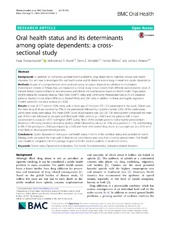| dc.contributor.author | Shekarchizadeh, Hajar | en_US |
| dc.contributor.author | Khami, Mohammad R. | en_US |
| dc.contributor.author | Mohebbi, Simin Z. | en_US |
| dc.contributor.author | Ekhtiari, Hamed | en_US |
| dc.contributor.author | Virtanen, Jorma | |
| dc.date.accessioned | 2019-05-29T08:55:46Z | |
| dc.date.available | 2019-05-29T08:55:46Z | |
| dc.date.issued | 2019-01-07 | |
| dc.Published | Shekarchizadeh, H., Khami, M. R., Mohebbi, S. Z., Ekhtiari, H., & Virtanen, J. I. Oral health status and its determinants among opiate dependents: a cross-sectional study. BMC oral health, 2019;19(1):5. | eng |
| dc.identifier.issn | 1472-6831 | |
| dc.identifier.uri | https://hdl.handle.net/1956/19797 | |
| dc.description.abstract | Background: In addition to numerous general health problems, drug dependents manifest various oral health disorders. Our aim was to investigate the oral health status and its determinants among in-treatment opiate dependents. Methods: As part of a comprehensive cross-sectional survey on opiate dependents admitted to methadone maintenance centers in Tehran, Iran, we conducted a clinical study in two centers from different socioeconomic areas. A trained dentist conducted face to face interviews and clinical oral examinations based on World Health Organization (WHO) criteria for Decayed, Missing, Filled Teeth (DMFT) index and Community Periodontal Index (CPI) on volunteer patients. Student’s t-test, Mann-Whitney U, Kruskal Wallis, and Chi2 tests, in addition to linear and logistic regression models served for statistical analysis (p < 0.05). Results: A total of 217 patients (98% men), with a mean age of 43.6 years (SD 12.3) participated in the study. Opium was the main drug of abuse reported by 70% of the participants followed by crystalline heroin (22%). Of the participants, 24.4% were totally edentulous. The mean DMFT score of participants was 20.3 (SD 7.8). Missing teeth comprised the main part of the index followed by decayed and filled teeth. Older patients (p < 0.001) and the patients with a lower socioeconomic status (p = 0.01) had higher DMFT scores. None of the dentate patients had a healthy periodontium. Maximum CPI mostly consisted of shallow pockets (66%) followed by calculus in 15%, deep pockets in 11%, and bleeding in 8% of the participants. Older participants (p = 0.02) and those who started drug abuse at a younger age (p = 0.01) were more likely to develop periodontal pockets. Conclusions: Opiate dependents had a poor oral health status in terms of the dentition status and periodontal health. Missing teeth comprised the main part of their dental caries history and none had a healthy periodontium. Oral health care should be integrated into the package of general health services available in treatment centers. | en_US |
| dc.language.iso | eng | eng |
| dc.publisher | BioMed Central | eng |
| dc.rights | Attribution CC BY | eng |
| dc.rights.uri | http://creativecommons.org/licenses/by/4.0 | eng |
| dc.subject | Dental caries | eng |
| dc.subject | Opioid-related disorders | eng |
| dc.subject | Oral health | eng |
| dc.subject | Periodontal index | eng |
| dc.subject | Substance-related disorders | eng |
| dc.title | Oral health status and its determinants among opiate dependents: a cross-sectional study | en_US |
| dc.type | Peer reviewed | |
| dc.type | Journal article | |
| dc.date.updated | 2019-01-18T09:41:46Z | |
| dc.description.version | publishedVersion | en_US |
| dc.rights.holder | Copyright 2019 The Author(s) | |
| dc.identifier.doi | https://doi.org/10.1186/s12903-018-0691-3 | |
| dc.identifier.cristin | 1701616 | |
| dc.source.journal | BMC Oral Health | |

